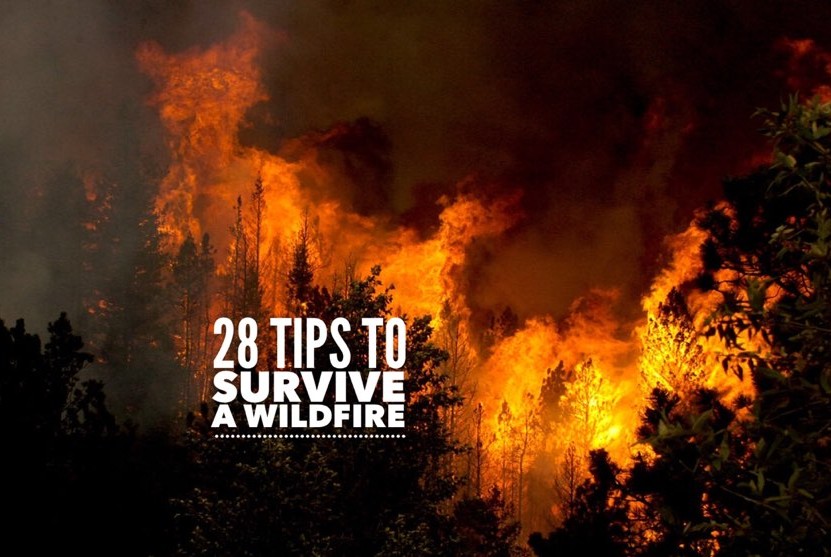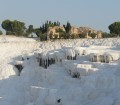Above image courtesy of US Air Force
Every year wildfires destroy millions of dollars worth of property, threaten and displace thousand of lives all around the world. Even as I write this, California, my home state, is suffering from over 2 dozen wildfires, with one massive blaze far from being contained. Unbelievably, wildfires are not rare, with the majority of them caused by people tossing cigarettes or failing to practice good fire safety.
Wildfires are destructive entities that are amplified by wind, limitless fuel sources and arid environments. With a rapid FROS (forward rate of speed) of 6.7mph, depending on wind conditions, wildfires can cleave a path of destruction eating everything in its wake. And if that wasn’t bad enough, natural barriers can’t even stop a wildfire, as they are known to “jump gaps” like highways and rivers.
Wildfires can occur anywhere with dry hot climates. They spread fast, change directions, and you’ll probably die from the smoke and heat before ever being touched by the flames. Battling and containing wildfires is also an incredibly challenging task. As firefighters risk their lives to control the blaze, it is our responsibility to help by also being self-reliant and practice self-rescue whenever possible.
Remember the acronym S.T.O.P – Sit, think, observe, plan, and follow these 28 tips to survive a wildfire:
Always Be Prepared:
- Have a bug out bag and emergency kit prepared so evacuation can be quick and decisive. Include items such as: multi tools, axe, friction saw, knife, shovel, radio, non-perishable foods, emergency numbers and maps.
- Have a pre-planned emergency rendezvous point in case you and your family are separated
- Be mindful and remove potential fire fuel sources around your home like dry vegetation and flammable debris
- Use materials in home construction and landscape that are fire retardant, and can potentially slow the burn rather than accelerate it (e.g. Hardwood trees instead of Fir Trees).
- Install a dual-sensor smoke alarm (one that can detect flames and flameless fires) in multiple areas of your home, especially the bedrooms. Be sure to test and keep the batteries fresh regularly
- Install fire extinguishers in multiple, accessible and low risk areas of your house, for instance, near the kitchen, but not IN the kitchen
- Store a ladder or climbing rope inside on the higher levels of your home in the event escape through the windows are necessary
- Install a water hose that can reach all areas outside, and inside, your home
During the Wildfire:
- Grab your bug out bag and emergency kit
- Wear practical clothing, in layers, like sturdy shoes, long durable pants, and long sleeve shirts
- Bring a bandana to cover the face and protect against smoke and particle inhalation
- Prepare your ladder or climbing rope for escape if necessary
- Shut off all gas and electricity at the source
- Place and turn on sprinklers on the roof of your house and douse your home with water
- Collect and move all flammable furniture and items into the center of your home away from windows and doors
- If evacuation and escape is necessary, use your car. Wildfires spread rapidly and your car is the quickest way to get some distance
- If in the car, roll up windows and close vents. Keep your headlights on and drive slowly while watching out for pedestrians, moving and stationary vehicles
- If immediate escape is not possible, stay low and cover up with a blanket or a coat if one is not available
- If immediate escape from your home is not possible, stay away from the walls, leave all doors unlocked and closed, and stay together. Hang the ladder or rope outside in a visible location, and attach a piece of cloth or bandana outside the window to attract attention
- Keep pets controlled, and with you at all times. Don’t give them an opportunity to run off
- If outdoors, and on foot, stay away from areas with plentiful fuel sources, canyons, valleys, and areas formed like a “saddle.” Stay low, and keep yourself covered with a flame retardant blanket to protect you from the heat and smoke. If being overrun by the wildfire, look for a hole or any cavity that’s far from any fuel source, lie face down in it and cover yourself up until the fire passes.
After the Wildfire:
- If separated from your family, head directly to your predetermined rendezvous point
- Find the nearest designated public shelter. In the U.S, text SHELTER + your zip code to 43362 (4FEMA).
- If at home, check the roof for any fires, or embers. Take shifts resting and staying awake to keep watch for any additional dangers
- Douse everything with water to minimize the chance of a new blaze, and also to keep dust particles down
- Be cautious of the environment. Wildfires can change the landscape and neighborhoods dramatically, so be observant for ash pits, unstable ground, downed power lines, contaminated water supplies, and collapsing structures to name a few.
- If evacuated, don’t return home until safe to do so
Be aware that these are just general tips to survive a wildfire scenario and in reality all survival situations will be unique. The most important piece of advice: stay calm. Panic makes everything worse, exacerbating your fear and ultimately replacing intelligent actions with reactive ones.
S.T.O.P – Sit, Think, Observe, Plan!
Anything I missed? Do you have any tips to survive a wildfire?
Carey
Latest posts by Carey (see all)
- Travel Hack Friday: #DIY Orange Peel Oil Candle #travelhacks - October 16, 2015
- Hanoi Vietnam, The Photoscape! #Hanoi #Vietnam #Southeastasia - October 5, 2015
- Travel Hack Friday: How to Find Edible Bugs - October 2, 2015















